oil change FIAT TIPO 5DOORS STATION WAGON 2020 Owner handbook (in English)
[x] Cancel search | Manufacturer: FIAT, Model Year: 2020, Model line: TIPO 5DOORS STATION WAGON, Model: FIAT TIPO 5DOORS STATION WAGON 2020Pages: 304, PDF Size: 9.12 MB
Page 66 of 304
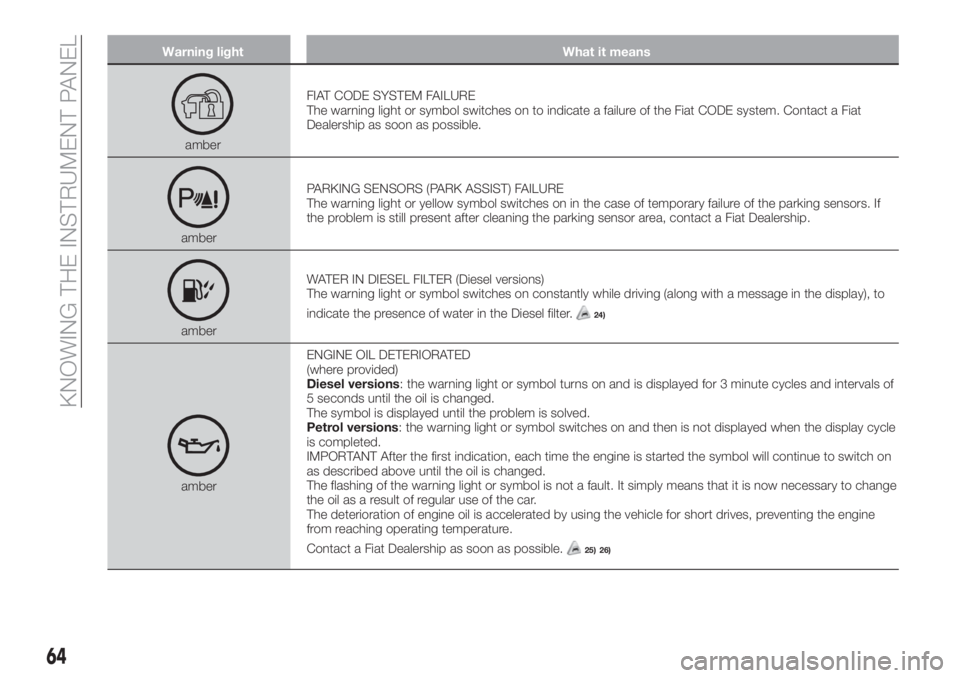
Warning light What it means
amberFIAT CODE SYSTEM FAILURE
The warning light or symbol switches on to indicate a failure of the Fiat CODE system. Contact a Fiat
Dealership as soon as possible.
amberPARKING SENSORS (PARK ASSIST) FAILURE
The warning light or yellow symbol switches on in the case of temporary failure of the parking sensors. If
the problem is still present after cleaning the parking sensor area, contact a Fiat Dealership.
amberWATER IN DIESEL FILTER (Diesel versions)
The warning light or symbol switches on constantly while driving (along with a message in the display), to
indicate the presence of water in the Diesel filter.
24)
amberENGINE OIL DETERIORATED
(where provided)
Diesel versions: the warning light or symbol turns on and is displayed for 3 minute cycles and intervals of
5 seconds until the oil is changed.
The symbol is displayed until the problem is solved.
Petrol versions: the warning light or symbol switches on and then is not displayed when the display cycle
is completed.
IMPORTANT After the first indication, each time the engine is started the symbol will continue to switch on
as described above until the oil is changed.
The flashing of the warning light or symbol is not a fault. It simply means that it is now necessary to change
the oil as a result of regular use of the car.
The deterioration of engine oil is accelerated by using the vehicle for short drives, preventing the engine
from reaching operating temperature.
Contact a Fiat Dealership as soon as possible.
25) 26)
64
KNOWING THE INSTRUMENT PANEL
Page 67 of 304
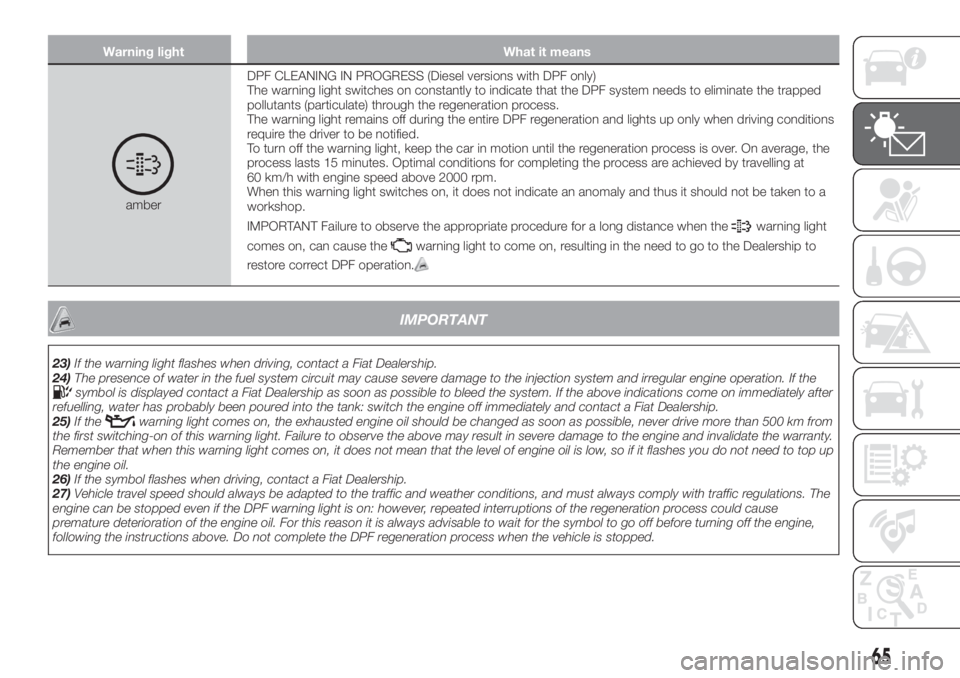
Warning light What it means
amberDPF CLEANING IN PROGRESS (Diesel versions with DPF only)
The warning light switches on constantly to indicate that the DPF system needs to eliminate the trapped
pollutants (particulate) through the regeneration process.
The warning light remains off during the entire DPF regeneration and lights up only when driving conditions
require the driver to be notified.
To turn off the warning light, keep the car in motion until the regeneration process is over. On average, the
process lasts 15 minutes. Optimal conditions for completing the process are achieved by travelling at
60 km/h with engine speed above 2000 rpm.
When this warning light switches on, it does not indicate an anomaly and thus it should not be taken to a
workshop.
IMPORTANT Failure to observe the appropriate procedure for a long distance when the
warning light
comes on, can cause the
warning light to come on, resulting in the need to go to the Dealership to
restore correct DPF operation.
IMPORTANT
23)If the warning light flashes when driving, contact a Fiat Dealership.
24)The presence of water in the fuel system circuit may cause severe damage to the injection system and irregular engine operation. If the
symbol is displayed contact a Fiat Dealership as soon as possible to bleed the system. If the above indications come on immediately after
refuelling, water has probably been poured into the tank: switch the engine off immediately and contact a Fiat Dealership.
25)If the
warning light comes on, the exhausted engine oil should be changed as soon as possible, never drive more than 500 km from
the first switching-on of this warning light. Failure to observe the above may result in severe damage to the engine and invalidate the warranty.
Remember that when this warning light comes on, it does not mean that the level of engine oil is low, so if it flashes you do not need to top up
the engine oil.
26)If the symbol flashes when driving, contact a Fiat Dealership.
27)Vehicle travel speed should always be adapted to the traffic and weather conditions, and must always comply with traffic regulations. The
engine can be stopped even if the DPF warning light is on: however, repeated interruptions of the regeneration process could cause
premature deterioration of the engine oil. For this reason it is always advisable to wait for the symbol to go off before turning off the engine,
following the instructions above. Do not complete the DPF regeneration process when the vehicle is stopped.
65
Page 185 of 304
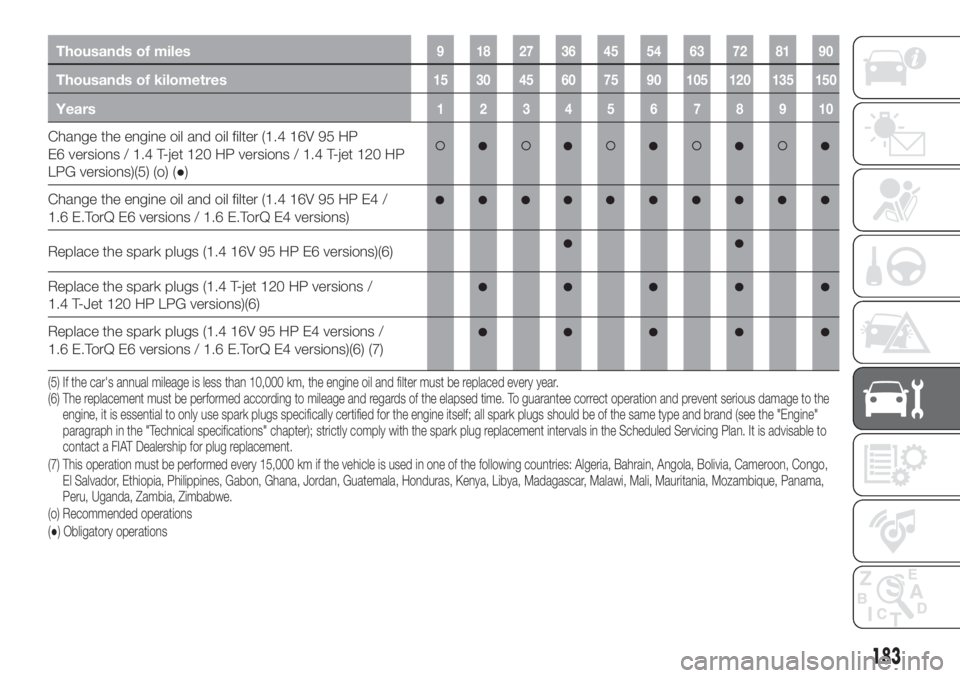
Thousands of miles9 182736455463728190
Thousands of kilometres15 30 45 60 75 90 105 120 135 150
Years12345678910
Change the engine oil and oil filter (1.4 16V 95 HP
E6 versions / 1.4 T-jet 120 HP versions / 1.4 T-jet 120 HP
LPG versions)(5) (o) (●)
Change the engine oil and oil filter (1.4 16V 95 HP E4 /
1.6 E.TorQ E6 versions / 1.6 E.TorQ E4 versions)
Replace the spark plugs (1.4 16V 95 HP E6 versions)(6)
Replace the spark plugs (1.4 T-jet 120 HP versions /
1.4 T-Jet 120 HP LPG versions)(6)
Replace the spark plugs (1.4 16V 95 HP E4 versions /
1.6 E.TorQ E6 versions / 1.6 E.TorQ E4 versions)(6) (7)
(5) If the car's annual mileage is less than 10,000 km, the engine oil and filter must be replaced every year.
(o) Recommended operations
(●) Obligatory operations (6) The replacement must be performed according to mileage and regards of the elapsed time. To guarantee correct operation and prevent serious damageto the
engine, it is essential to only use spark plugs specifically certified for the engine itself; all spark plugs should be of the same type and brand (see the "Engine"
paragraph in the "Technical specifications" chapter); strictly comply with the spark plug replacement intervals in the Scheduled Servicing Plan. It is advisable to
contact a FIAT Dealership for plug replacement.
(7) This operation must be performed every 15,000 km if the vehicle is used in one of the following countries: Algeria, Bahrain, Angola, Bolivia, Cameroon, Congo,
El Salvador, Ethiopia, Philippines, Gabon, Ghana, Jordan, Guatemala, Honduras, Kenya, Libya, Madagascar, Malawi, Mali, Mauritania, Mozambique,Panama,
Peru, Uganda, Zambia, Zimbabwe.
183
Page 190 of 304
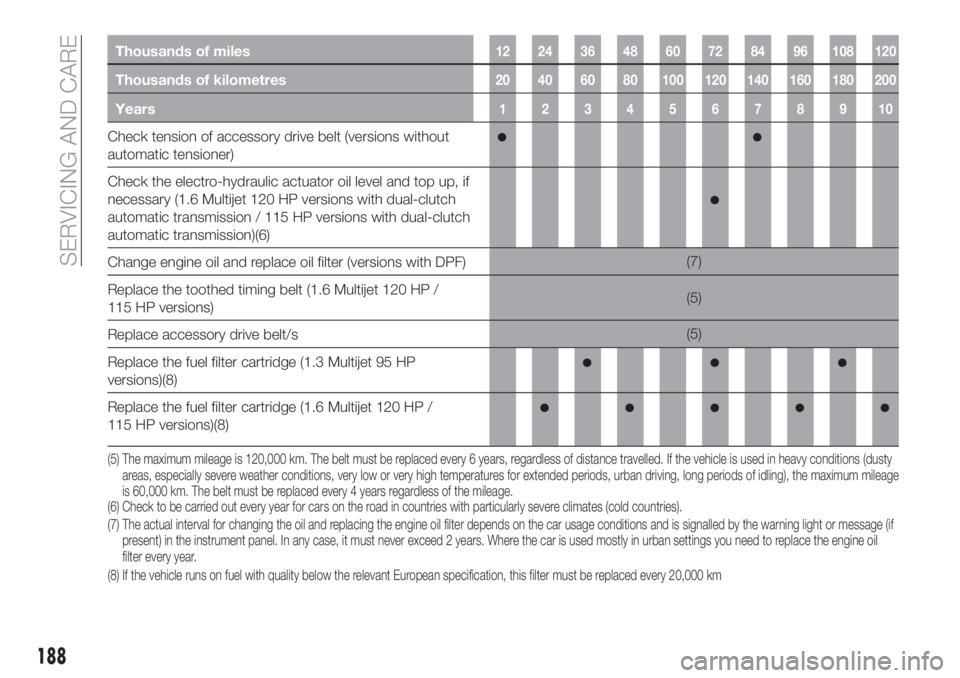
Thousands of miles12 24 36 48 60 72 84 96 108 120
Thousands of kilometres20 40 60 80 100 120 140 160 180 200
Years12345678910
Check tension of accessory drive belt (versions without
automatic tensioner)
Check the electro-hydraulic actuator oil level and top up, if
necessary (1.6 Multijet 120 HP versions with dual-clutch
automatic transmission / 115 HP versions with dual-clutch
automatic transmission)(6)
Change engine oil and replace oil filter (versions with DPF)(7)
Replace the toothed timing belt (1.6 Multijet 120 HP /
115 HP versions)(5)
Replace accessory drive belt/s(5)
Replace the fuel filter cartridge (1.3 Multijet 95 HP
versions)(8)
Replace the fuel filter cartridge (1.6 Multijet 120 HP /
115 HP versions)(8)
(6) Check to be carried out every year for cars on the road in countries with particularly severe climates (cold countries).
(7) The actual interval for changing the oil and replacing the engine oil filter depends on the car usage conditions and is signalled by the warning light or message (if
present) in the instrument panel. In any case, it must never exceed 2 years. Where the car is used mostly in urban settings you need to replace the engine oil
filter every year. (5) The maximum mileage is 120,000 km. The belt must be replaced every 6 years, regardless of distance travelled. If the vehicle is used in heavy conditions (dusty
areas, especially severe weather conditions, very low or very high temperatures for extended periods, urban driving, long periods of idling), the maximum mileage
is 60,000 km. The belt must be replaced every 4 years regardless of the mileage.
(8) If the vehicle runs on fuel with quality below the relevant European specification, this filter must be replaced every 20,000 km
188
SERVICING AND CARE
Page 192 of 304
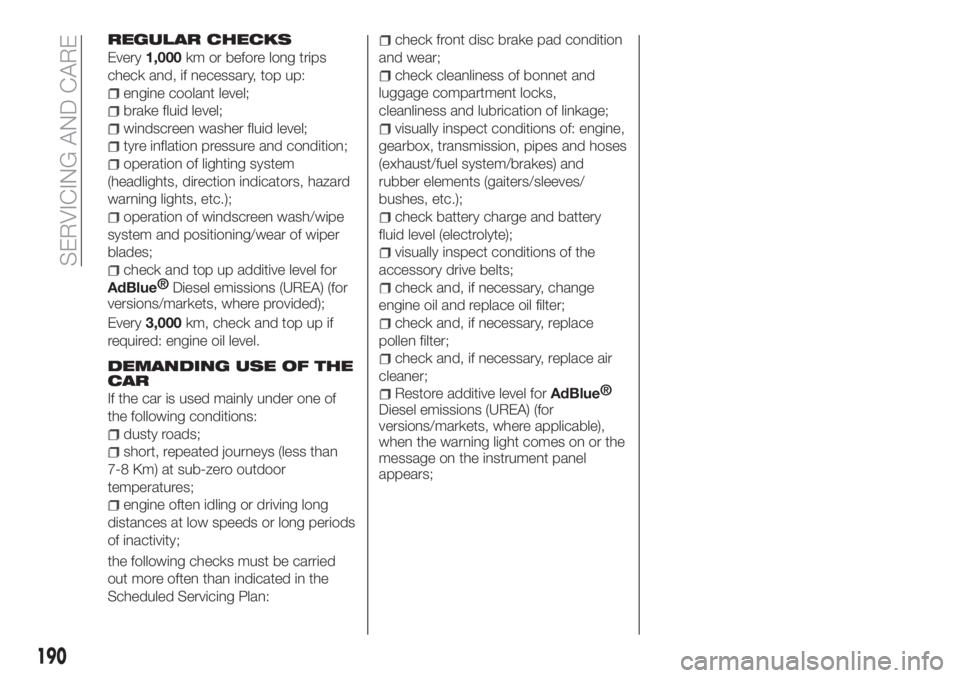
REGULAR CHECKS
Every1,000km or before long trips
check and, if necessary, top up:
engine coolant level;
brake fluid level;
windscreen washer fluid level;
tyre inflation pressure and condition;
operation of lighting system
(headlights, direction indicators, hazard
warning lights, etc.);
operation of windscreen wash/wipe
system and positioning/wear of wiper
blades;
check and top up additive level for
AdBlue®
Diesel emissions (UREA) (for
versions/markets, where provided);
Every3,000km, check and top up if
required: engine oil level.
DEMANDING USE OF THE
CAR
If the car is used mainly under one of
the following conditions:
dusty roads;
short, repeated journeys (less than
7-8 Km) at sub-zero outdoor
temperatures;
engine often idling or driving long
distances at low speeds or long periods
of inactivity;
the following checks must be carried
out more often than indicated in the
Scheduled Servicing Plan:
check front disc brake pad condition
and wear;
check cleanliness of bonnet and
luggage compartment locks,
cleanliness and lubrication of linkage;
visually inspect conditions of: engine,
gearbox, transmission, pipes and hoses
(exhaust/fuel system/brakes) and
rubber elements (gaiters/sleeves/
bushes, etc.);
check battery charge and battery
fluid level (electrolyte);
visually inspect conditions of the
accessory drive belts;
check and, if necessary, change
engine oil and replace oil filter;
check and, if necessary, replace
pollen filter;
check and, if necessary, replace air
cleaner;
Restore additive level forAdBlue®
Diesel emissions (UREA) (for
versions/markets, where applicable),
when the warning light comes on or the
message on the instrument panel
appears;
190
SERVICING AND CARE
Page 204 of 304
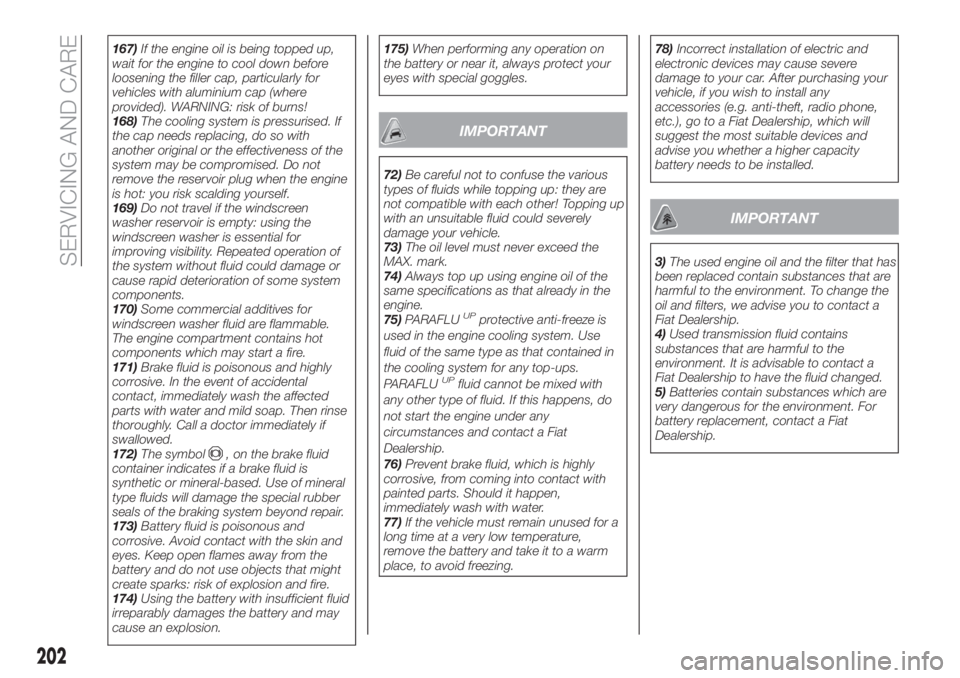
167)If the engine oil is being topped up,
wait for the engine to cool down before
loosening the filler cap, particularly for
vehicles with aluminium cap (where
provided). WARNING: risk of burns!
168)The cooling system is pressurised. If
the cap needs replacing, do so with
another original or the effectiveness of the
system may be compromised. Do not
remove the reservoir plug when the engine
is hot: you risk scalding yourself.
169)Do not travel if the windscreen
washer reservoir is empty: using the
windscreen washer is essential for
improving visibility. Repeated operation of
the system without fluid could damage or
cause rapid deterioration of some system
components.
170)Some commercial additives for
windscreen washer fluid are flammable.
The engine compartment contains hot
components which may start a fire.
171)Brake fluid is poisonous and highly
corrosive. In the event of accidental
contact, immediately wash the affected
parts with water and mild soap. Then rinse
thoroughly. Call a doctor immediately if
swallowed.
172)The symbol
, on the brake fluid
container indicates if a brake fluid is
synthetic or mineral-based. Use of mineral
type fluids will damage the special rubber
seals of the braking system beyond repair.
173)Battery fluid is poisonous and
corrosive. Avoid contact with the skin and
eyes. Keep open flames away from the
battery and do not use objects that might
create sparks: risk of explosion and fire.
174)Using the battery with insufficient fluid
irreparably damages the battery and may
cause an explosion.175)When performing any operation on
the battery or near it, always protect your
eyes with special goggles.
IMPORTANT
72)Be careful not to confuse the various
types of fluids while topping up: they are
not compatible with each other! Topping up
with an unsuitable fluid could severely
damage your vehicle.
73)The oil level must never exceed the
MAX. mark.
74)Always top up using engine oil of the
same specifications as that already in the
engine.
75)PARAFLU
UPprotective anti-freeze is
used in the engine cooling system. Use
fluid of the same type as that contained in
the cooling system for any top-ups.
PARAFLU
UPfluid cannot be mixed with
any other type of fluid. If this happens, do
not start the engine under any
circumstances and contact a Fiat
Dealership.
76)Prevent brake fluid, which is highly
corrosive, from coming into contact with
painted parts. Should it happen,
immediately wash with water.
77)If the vehicle must remain unused for a
long time at a very low temperature,
remove the battery and take it to a warm
place, to avoid freezing.78)Incorrect installation of electric and
electronic devices may cause severe
damage to your car. After purchasing your
vehicle, if you wish to install any
accessories (e.g. anti-theft, radio phone,
etc.), go to a Fiat Dealership, which will
suggest the most suitable devices and
advise you whether a higher capacity
battery needs to be installed.
IMPORTANT
3)The used engine oil and the filter that has
been replaced contain substances that are
harmful to the environment. To change the
oil and filters, we advise you to contact a
Fiat Dealership.
4)Used transmission fluid contains
substances that are harmful to the
environment. It is advisable to contact a
Fiat Dealership to have the fluid changed.
5)Batteries contain substances which are
very dangerous for the environment. For
battery replacement, contact a Fiat
Dealership.
202
SERVICING AND CARE
Page 206 of 304
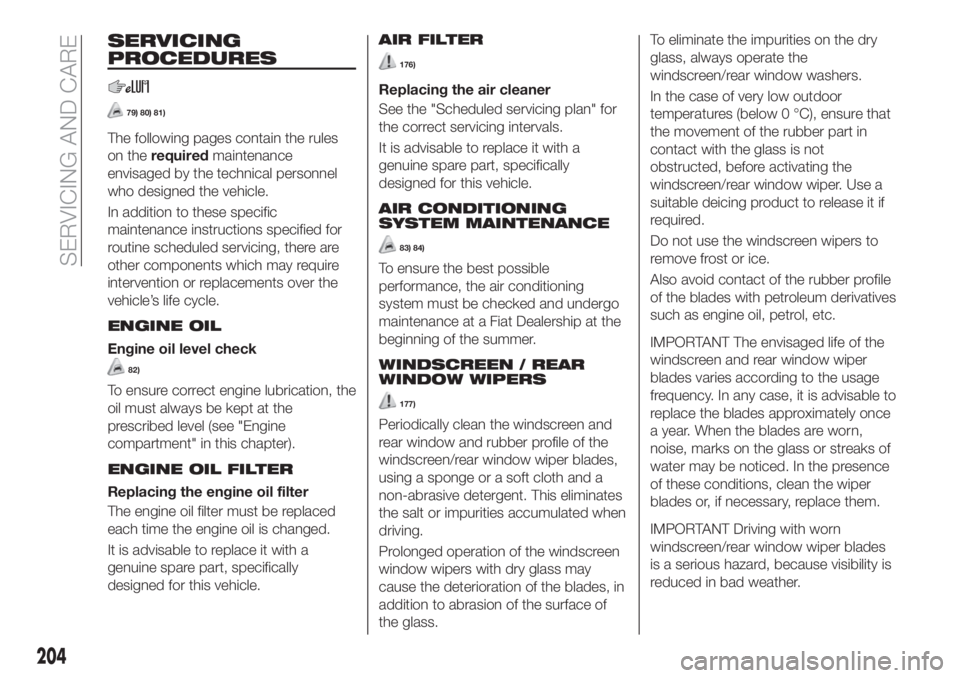
SERVICING
PROCEDURES
79) 80) 81)
The following pages contain the rules
on therequiredmaintenance
envisaged by the technical personnel
who designed the vehicle.
In addition to these specific
maintenance instructions specified for
routine scheduled servicing, there are
other components which may require
intervention or replacements over the
vehicle’s life cycle.
ENGINE OIL
Engine oil level check
82)
To ensure correct engine lubrication, the
oil must always be kept at the
prescribed level (see "Engine
compartment" in this chapter).
ENGINE OIL FILTER
Replacing the engine oil filter
The engine oil filter must be replaced
each time the engine oil is changed.
It is advisable to replace it with a
genuine spare part, specifically
designed for this vehicle.
AIR FILTER
176)
Replacing the air cleaner
See the "Scheduled servicing plan" for
the correct servicing intervals.
It is advisable to replace it with a
genuine spare part, specifically
designed for this vehicle.
AIR CONDITIONING
SYSTEM MAINTENANCE
83) 84)
To ensure the best possible
performance, the air conditioning
system must be checked and undergo
maintenance at a Fiat Dealership at the
beginning of the summer.
WINDSCREEN / REAR
WINDOW WIPERS
177)
Periodically clean the windscreen and
rear window and rubber profile of the
windscreen/rear window wiper blades,
using a sponge or a soft cloth and a
non-abrasive detergent. This eliminates
the salt or impurities accumulated when
driving.
Prolonged operation of the windscreen
window wipers with dry glass may
cause the deterioration of the blades, in
addition to abrasion of the surface of
the glass.To eliminate the impurities on the dry
glass, always operate the
windscreen/rear window washers.
In the case of very low outdoor
temperatures (below 0 °C), ensure that
the movement of the rubber part in
contact with the glass is not
obstructed, before activating the
windscreen/rear window wiper. Use a
suitable deicing product to release it if
required.
Do not use the windscreen wipers to
remove frost or ice.
Also avoid contact of the rubber profile
of the blades with petroleum derivatives
such as engine oil, petrol, etc.
IMPORTANT The envisaged life of the
windscreen and rear window wiper
blades varies according to the usage
frequency. In any case, it is advisable to
replace the blades approximately once
a year. When the blades are worn,
noise, marks on the glass or streaks of
water may be noticed. In the presence
of these conditions, clean the wiper
blades or, if necessary, replace them.
IMPORTANT Driving with worn
windscreen/rear window wiper blades
is a serious hazard, because visibility is
reduced in bad weather.
204
SERVICING AND CARE
Page 294 of 304
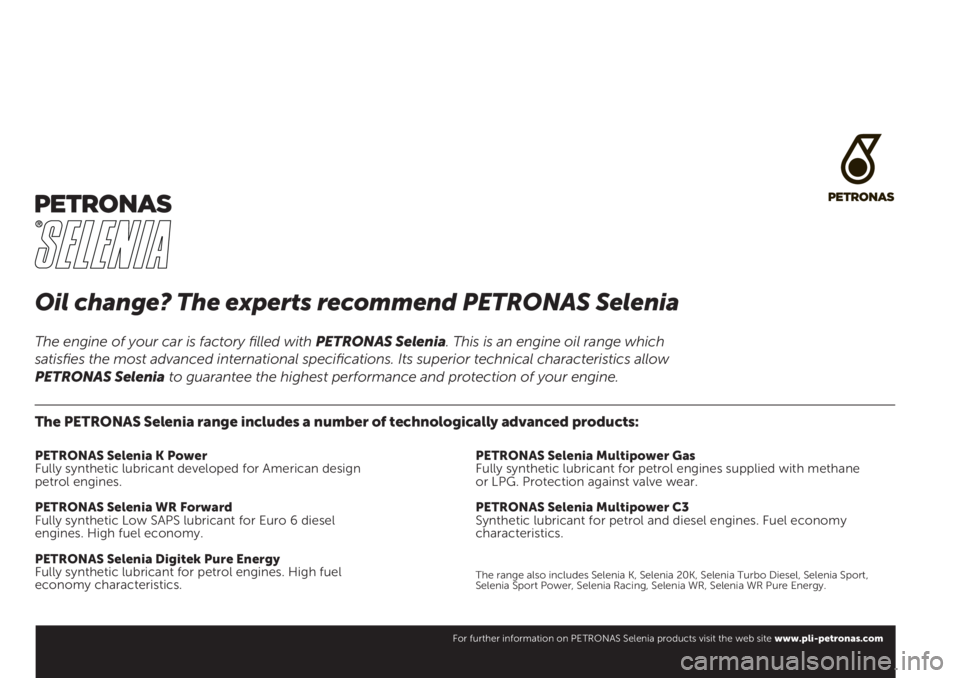
Oil change? The experts recommend PETRONAS Selenia
The PETRONAS Selenia range includes a number of technologically advanced products:
PETRONAS Selenia K Power
Fully synthetic lubricant developed for American design
petrol engines.
PETRONAS Selenia WR Forward
Fully synthetic Low SAPS lubricant for Euro 6 diesel
engines. High fuel economy.
PETRONAS Selenia Digitek Pure Energy
Fully synthetic lubricant for petrol engines. High fuel
economy characteristics.PETRONAS Selenia Multipower Gas
Fully synthetic lubricant for petrol engines supplied with methane
or LPG. Protection against valve wear.
PETRONAS Selenia Multipower C3
Synthetic lubricant for petrol and diesel engines. Fuel economy
characteristics.
The range also includes Selenia K, Selenia 20K, Selenia Turbo Diesel, Selenia Sport,
Selenia Sport Power, Selenia Racing, Selenia WR, Selenia WR Pure Energy.
The engine of your car is factory filled with PETRONAS Selenia. This is an engine oil range which
satisfies the most advanced international specifications. Its superior technical characteristics allow
PETRONAS Selenia to guarantee the highest performance and protection of your engine.
For further information on PETRONAS Selenia products visit the web site www.pli-petronas.com